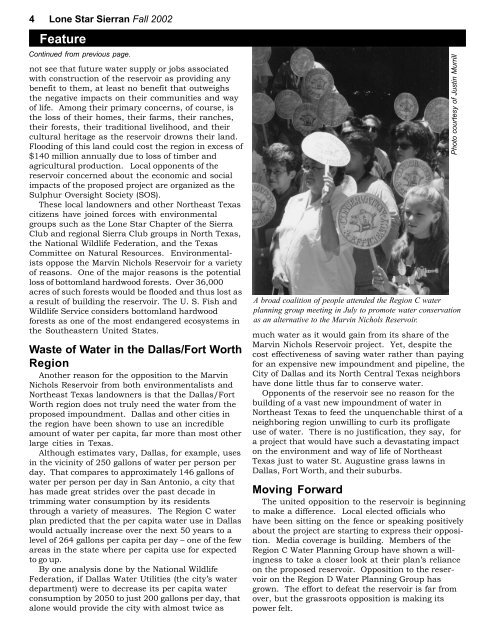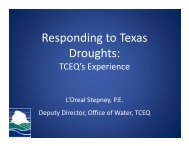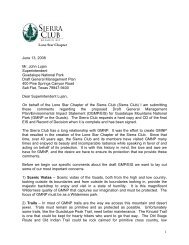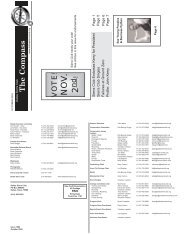Fall 2002 - Lone Star Chapter, Sierra Club
Fall 2002 - Lone Star Chapter, Sierra Club
Fall 2002 - Lone Star Chapter, Sierra Club
You also want an ePaper? Increase the reach of your titles
YUMPU automatically turns print PDFs into web optimized ePapers that Google loves.
4 <strong>Lone</strong> <strong>Star</strong> <strong>Sierra</strong>n <strong>Fall</strong> <strong>2002</strong><br />
Feature<br />
Continued from previous page.<br />
not see that future water supply or jobs associated<br />
with construction of the reservoir as providing any<br />
benefit to them, at least no benefit that outweighs<br />
the negative impacts on their communities and way<br />
of life. Among their primary concerns, of course, is<br />
the loss of their homes, their farms, their ranches,<br />
their forests, their traditional livelihood, and their<br />
cultural heritage as the reservoir drowns their land.<br />
Flooding of this land could cost the region in excess of<br />
$140 million annually due to loss of timber and<br />
agricultural production. Local opponents of the<br />
reservoir concerned about the economic and social<br />
impacts of the proposed project are organized as the<br />
Sulphur Oversight Society (SOS).<br />
These local landowners and other Northeast Texas<br />
citizens have joined forces with environmental<br />
groups such as the <strong>Lone</strong> <strong>Star</strong> <strong>Chapter</strong> of the <strong>Sierra</strong><br />
<strong>Club</strong> and regional <strong>Sierra</strong> <strong>Club</strong> groups in North Texas,<br />
the National Wildlife Federation, and the Texas<br />
Committee on Natural Resources. Environmentalists<br />
oppose the Marvin Nichols Reservoir for a variety<br />
of reasons. One of the major reasons is the potential<br />
loss of bottomland hardwood forests. Over 36,000<br />
acres of such forests would be flooded and thus lost as<br />
a result of building the reservoir. The U. S. Fish and<br />
Wildlife Service considers bottomland hardwood<br />
forests as one of the most endangered ecosystems in<br />
the Southeastern United States.<br />
Waste of Water in the Dallas/Fort Worth<br />
Region<br />
Another reason for the opposition to the Marvin<br />
Nichols Reservoir from both environmentalists and<br />
Northeast Texas landowners is that the Dallas/Fort<br />
Worth region does not truly need the water from the<br />
proposed impoundment. Dallas and other cities in<br />
the region have been shown to use an incredible<br />
amount of water per capita, far more than most other<br />
large cities in Texas.<br />
Although estimates vary, Dallas, for example, uses<br />
in the vicinity of 250 gallons of water per person per<br />
day. That compares to approximately 146 gallons of<br />
water per person per day in San Antonio, a city that<br />
has made great strides over the past decade in<br />
trimming water consumption by its residents<br />
through a variety of measures. The Region C water<br />
plan predicted that the per capita water use in Dallas<br />
would actually increase over the next 50 years to a<br />
level of 264 gallons per capita per day – one of the few<br />
areas in the state where per capita use for expected<br />
to go up.<br />
By one analysis done by the National Wildlife<br />
Federation, if Dallas Water Utilities (the city’s water<br />
department) were to decrease its per capita water<br />
consumption by 2050 to just 200 gallons per day, that<br />
alone would provide the city with almost twice as<br />
A broad coalition of people attended the Region C water<br />
planning group meeting in July to promote water conservation<br />
as an alternative to the Marvin Nichols Reservoir.<br />
much water as it would gain from its share of the<br />
Marvin Nichols Reservoir project. Yet, despite the<br />
cost effectiveness of saving water rather than paying<br />
for an expensive new impoundment and pipeline, the<br />
City of Dallas and its North Central Texas neighbors<br />
have done little thus far to conserve water.<br />
Opponents of the reservoir see no reason for the<br />
building of a vast new impoundment of water in<br />
Northeast Texas to feed the unquenchable thirst of a<br />
neighboring region unwilling to curb its profligate<br />
use of water. There is no justification, they say, for<br />
a project that would have such a devastating impact<br />
on the environment and way of life of Northeast<br />
Texas just to water St. Augustine grass lawns in<br />
Dallas, Fort Worth, and their suburbs.<br />
Moving Forward<br />
The united opposition to the reservoir is beginning<br />
to make a difference. Local elected officials who<br />
have been sitting on the fence or speaking positively<br />
about the project are starting to express their opposition.<br />
Media coverage is building. Members of the<br />
Region C Water Planning Group have shown a willingness<br />
to take a closer look at their plan’s reliance<br />
on the proposed reservoir. Opposition to the reservoir<br />
on the Region D Water Planning Group has<br />
grown. The effort to defeat the reservoir is far from<br />
over, but the grassroots opposition is making its<br />
power felt.<br />
Photo courtesy of Justin Murrill







